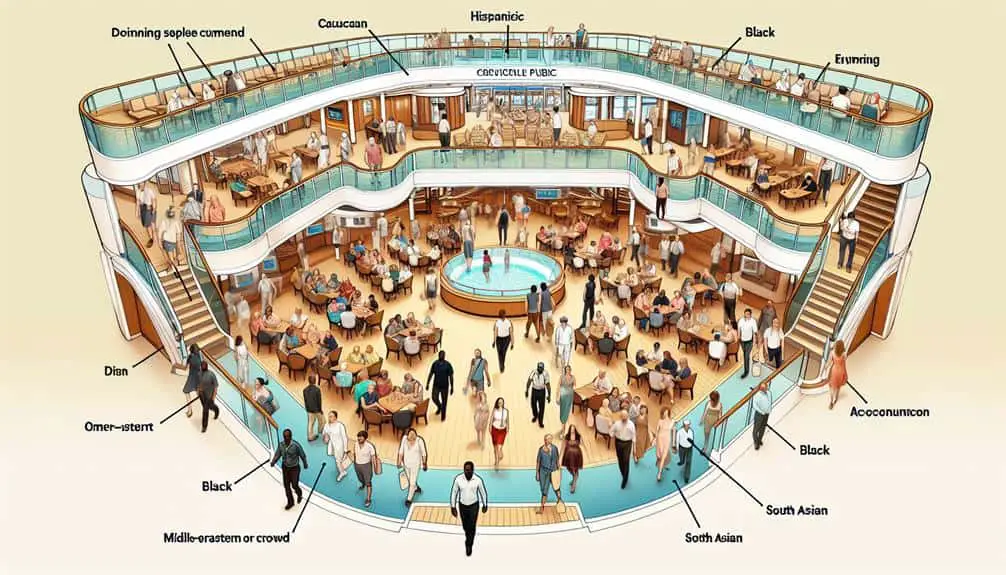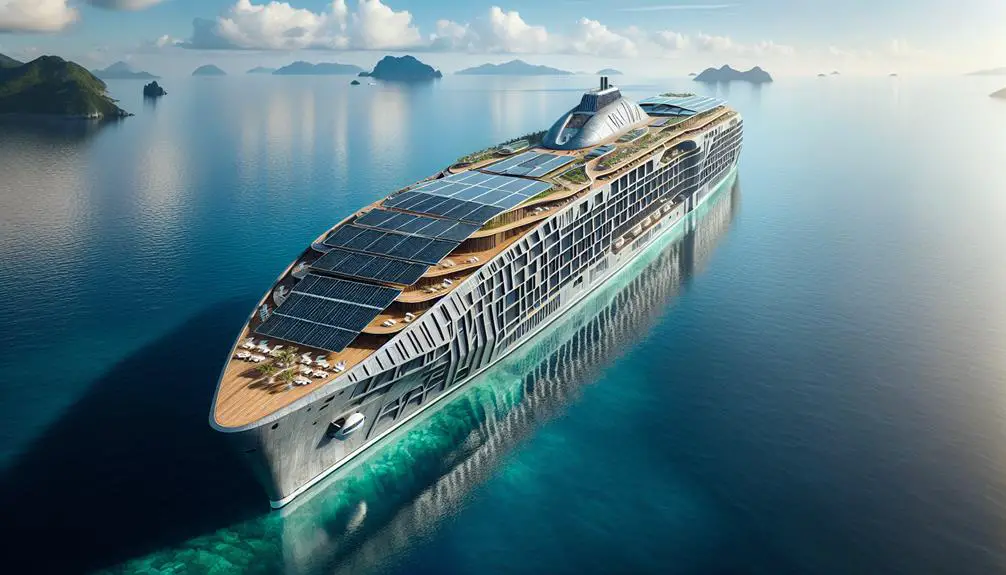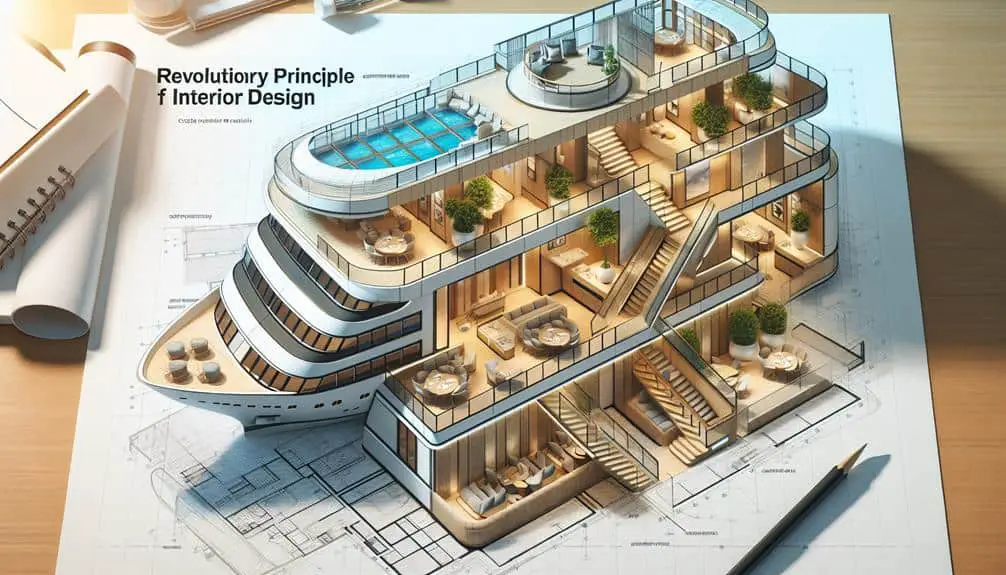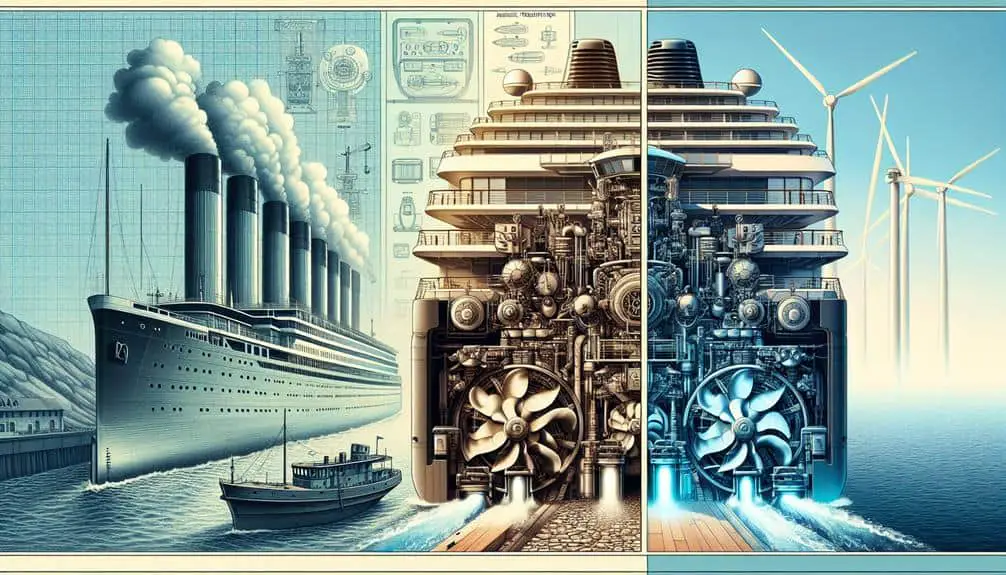Enhance your cruise ship public areas: 1) Opt for multifunctional furniture to save space. 2) Use clear signage for easy navigation. 3) Design efficient traffic flow for smooth movement. 4) Install ideal lighting and sound systems. 5) Create flexible spaces for diverse uses. Discover innovative ways to elevate passenger comfort and maximize efficiency onboard.
Key Points
- Utilize multifunctional furniture for space efficiency and usability.
- Implement clear signage systems with visibility and interactivity.
- Design efficient traffic flow with dynamic layouts and clear pathways.
- Optimize lighting and acoustics for ambiance and comfort.
- Create flexible use spaces for varied activities and social interaction.
Utilize Multifunctional Furniture
To enhance space efficiency and functionality on cruise ships, consider incorporating multifunctional furniture designs that seamlessly transform to meet various needs. Space-saving solutions are important in maximizing the usability of public areas on cruise ships. Opt for furniture pieces that serve dual purposes, such as ottomans with hidden storage compartments or tables that can be extended or folded to accommodate different group sizes. By utilizing furniture functionality effectively, you can create versatile spaces that adapt to various activities throughout the day.
When selecting furniture for cruise ship public areas, prioritize pieces that can be easily reconfigured to optimize the available space. Look for innovative designs that prioritize both form and function, adding a touch of style to the surroundings. With multifunctional furniture, you can create dynamic layouts that cater to different events and guest preferences. Embrace creativity in your furniture choices to elevate the overall experience for passengers and make the most of every square foot onboard.
Implement Clear Signage Systems
Enhance the navigational experience for passengers by implementing a sleek and intuitive signage system throughout the cruise ship's public areas. Maximizing visibility and minimizing clutter are key principles to take into account when designing your signage strategy.
Here are three innovative tips to help you achieve an efficient signage system:
- Contrast is Key: Utilize contrasting colors to make your signs stand out against the background. This will maximize visibility, especially in areas with high foot traffic or where lighting conditions may vary.
- Clear and Concise Messaging: Keep your signage informative yet brief. Use clear and straightforward language to convey directions or information effectively, minimizing clutter and confusion for passengers.
- Interactive Digital Signage: Incorporate interactive digital displays that can provide real-time updates on events, activities, or changes in schedules. This modern approach not only enhances the passenger experience but also reduces the need for multiple static signs, further minimizing visual clutter.
Design Efficient Traffic Flow
Maximize passenger comfort and convenience by crafting a dynamic layout that streamlines the flow of movement throughout the cruise ship's public areas. Efficient traffic flow is crucial to guarantee that passengers can navigate the ship effortlessly. Utilize innovative wayfinding solutions such as digital displays, interactive maps, and strategically placed signage to guide guests seamlessly from one area to another. Clear pathways and designated walkways can prevent congestion and enhance the overall guest experience.
When designing seating arrangements, consider both functionality and style. Opt for versatile furniture that can be easily reconfigured to adapt to different activities or group sizes. Integrate comfortable seating options in strategic locations to encourage relaxation and social interaction. By combining ergonomic design with aesthetic appeal, you can create inviting spaces that cater to the diverse needs of passengers.
Optimize Lighting and Acoustics
Efficiently optimize lighting and acoustics to create a harmonious ambiance that complements the cruise ship's public areas. Enhancing the ambiance through strategic lighting and sound management can notably elevate the overall experience for passengers. To achieve this, consider the following:
- Utilize LED Lighting: Implement energy-efficient LED lighting solutions throughout the public areas. LED lights not only consume less energy but also offer customizable options to set the desired mood and ambiance.
- Incorporate Sound-absorbing Materials: Integrate sound-absorbing materials such as acoustic panels or carpets to reduce noise levels and create a more peaceful environment. These materials can help minimize echoes and disturbances, enhancing passenger comfort.
- Adjustable Lighting Schemes: Install lighting fixtures with adjustable settings to cater to different activities and times of the day. This flexibility allows you to create the perfect ambiance for various events while also saving energy when full brightness isn't required.
Incorporate Flexible Use Spaces
Consider converting underutilized spaces into versatile areas that can adapt to various needs and activities onboard the cruise ship. By including collaborative seating arrangements, you can create dynamic environments that promote social interaction and cultivate a sense of community among passengers. These flexible spaces can easily shift from casual lounges during the day to interactive group settings for games, workshops, or presentations in the evening.
To enhance the functionality of these areas, integrate interactive displays that provide valuable information, entertainment, or even serve as digital signage for upcoming events. By integrating technology into these spaces, you can offer passengers a multi-faceted experience that's both engaging and informative.
Frequently Asked Questions
How Can Cruise Ship Public Areas Be Designed to Accommodate Passengers With Mobility Limitations or Disabilities?
To accommodate passengers with mobility limitations or disabilities, guarantee cruise ship public areas incorporate accessibility features like ramps and elevators. Design spaces with universal access in mind, providing mobility assistance and inclusive design for all guests.
What Safety Measures Should Be Taken Into Consideration When Designing Cruise Ship Public Areas?
When designing cruise ship public areas, safety regulations must be strictly adhered to. Accessible design features like ramps, handrails, and non-slip flooring should be incorporated. Prioritizing safety guarantees a secure and enjoyable experience for all passengers.
Are There Any Specific Regulations or Guidelines That Cruise Ship Designers Need to Follow When Creating Public Spaces on Board?
When designing cruise ship public areas, regulations and guidelines must be followed to guarantee accessibility and inclusivity. Prioritize safety, comfort, and aesthetics in your design. Consider the diverse needs of passengers to create efficient and attractive spaces.
How Can Cruise Ship Public Areas Be Designed to Cater to a Diverse Range of Passenger Preferences and Needs?
To cater to diverse passenger needs and create an inclusive design in cruise ship public areas, consider varied seating options, interactive technology, clear signage, and flexible layouts. Enhance passenger experience with thoughtful, stylish, and functional design choices.
What Are Some Innovative Ways to Incorporate Sustainable and Eco-Friendly Design Elements Into Cruise Ship Public Areas?
To infuse sustainable design into cruise ship public areas, consider incorporating energy-efficient lighting, recyclable materials, and green spaces. Provide accessibility options with ramps, elevators, and Braille signage. By blending style and environmental consciousness, you can create an inclusive and eco-friendly space.




